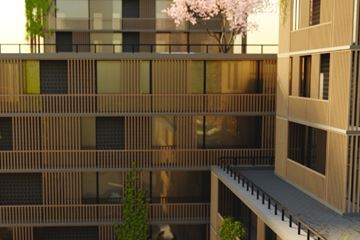

Choosing a home loan
Things you should consider when selecting a home loan
Choosing an interest rate type - variable or fixed?
A home loan’s interest rate will either be a variable rate that moves up or down or a fixed rate that stays the same during the loan term. You can also split your loan into fixed or variable portions. Here’s everything you need to know about choosing an interest rate.
Variable interest rates
The most popular loan type in Australia because of it’s financial versatility. Variable interest rates will shift many times during the lifetime of a loan; which will lower and increase your repayments. Many variable rate products offer flexible options to maximise your savings and minimise how much interest you pay.
Variable interest rates will move up and down as lenders respond to the cash rate set by the Reserve Bank of Australia (RBA). As lenders do not adjust their rates in-line with the RBA or each other, it’s important to thoroughly compare both a wide range of lenders and different products.
Variable rate home loans can come in either basic or standard packages and it’s important to know the differences and benefits of both.
Basic vs Standard
Basic home loans are generally used by borrowers with smaller loan amounts or who do not need any additional product features. Basic home loans will have lower interest rates and no annual fees.
A Standard home loan is attractive for borrowers who want:
- Flexibility with their repayments
- Simple features that help pay off their loan faster
- Access to extra repayments
Additional features in variable rate home loans
Here’s an overview of the main features you’ll find in most standard variable rate home loans:
- Interest only repayments allow borrowers to lower their payments by paying off only the interest portion of their loan. This can help borrowers if they need to free up money for other things such as school fees or home renovations. It’s important to know that when you make only interest payments you won’t reduce the balance of your loan.
Lisa has a $300,000 home loan with a 25 year term and 5% interest rate. Her repayments are $1,753 a month. Lisa decided she wanted to switch her repayments to interest only and her repayments dropped to $1,250 a month - $503 less than she was paying before.
- An offset account allows a borrower to hold savings in a separate account that is credited towards the loan balance. If you ever need the savings you can move the funds out with no penalty or fees. An offset account is a great idea for anyone with a large savings pool but needs flexibility in accessing that cash quickly.
Josh has a home loan worth $400,000. Over the course of the 25 year loan he will pay $319,000 in interest. If he kept $50,000 in an offset account he would have saved $40,000 in interest repayments (25 year loan at 5.25%)
- Additional repayments/ redraw facility. Variable rate products often allow you to make additional loan repayments when you have extra savings you’d like to put towards the balance of your loan. If things change in the future and you need those funds, a redraw facility will allow you to access the extra money you’ve paid.
- Loan splits. If you’re not 100% comfortable leaving your entire loan balance open to the movements of your lenders interest rate, you can absorb some of the risk of interest rate movements by splitting a portion of your loan between a variable interest rate and fixed one.
Fixed interest rates
Fixed interest rate loans let you lock in an interest rate so you know exactly what your monthly repayments will be. A fixed rate home loan is great for anyone who wants certainty about what their monthly repayments will be.
A fixed rate home loan gives you the confidence to budget for your lifestyle and plan your finances for a set period of time but it’s important to know and understand the benefits and disadvantages of a fixed interest rate.
Benefits of a fixed interest rate
Certainty of repayments - as the market is difficult to predict, a fixed rate home loan can offer a solution to an unpredictable future. A fixed home loan gives you certainty that your repayments will not only be the same every month, but safeguards you against future interest rate rises.
- Makes budgeting easy - a fixed interest rate makes it easy to organize your outgoing expenses for households planning their budgets or an investor managing their cash flow.
- Safeguard against future rate rises - the movements of the Reserve Bank of Australia’s (RBA) cash rate have an immediate impact on variable home loan rates but not on fixed interest rates. You can watch rates rise knowing your interest rate stays the same. It’s important to keep an eye on rates when your loan term is coming to an end as it’s a guarantee your rate will change.
- You can choose your term - generally speaking, fixed rate home loans are usually locked in for 1-5 years but can sometimes be longer depending on the loan purpose and the borrowers personal circumstances. The amount of time you fix your home loan rate can be dependant on factors such as how long you plan on living in your property or if you‘re using it as an investment.
- You can split your loan - almost all lenders will let you split your home loan between a fixed and a variable interest rate. This lets you adjust your financial strategy and take advantage of market conditions.
Further key influences include how much your repayment amounts will be as well as other fees and charges. See also variable rate home loans and split loans.
Disadvantages of a fixed interest rate
- You can miss out on lower rates - if rates drop below your agreed fixed rate, yours won’t. This means you won't benefit from a lower interest rate.
- Restrictions on repayments - extra repayments are usually capped, meaning there are restrictions on how much extra you can pay.
- Costs to exit the loan - most fixed rate products have costs involved with exiting or discharging the loan before the term is up. It’s important to know these costs before you sign up for a fixed loan.
What is a variable rate home loan?
Variable home loan rates give you flexibility and extra features to save you money. Your variable interest rate will move up and down over time, loosely in line with the official interest rates set by the Reserve Bank of Australia (RBA).
What is a fixed home loan?
You can lock in your home loan rate so you have a set repayment each month for a certain amount of time. A fixed interest rate is good for a borrower who wants certainty about their repayments and likes being able to budget around a set amount.



